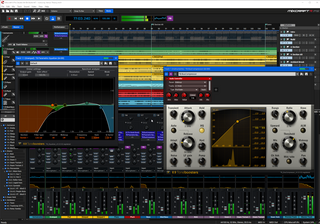
Modular synthesizers are synthesizers composed of separate modules for different functions. The modules can be connected together by the user to create a patch. The outputs from the modules may include audio signals, analog control voltages, or digital signals for logic or timing conditions. Typical modules are voltage-controlled oscillators, voltage-controlled filters, voltage-controlled amplifiers and envelope generators.

FL Studio is a digital audio workstation (DAW) developed by the Belgian company Image-Line. It features a graphical user interface with a pattern-based music sequencer. It is available in four different editions for Microsoft Windows and macOS.

Cubase is a digital audio workstation (DAW) developed by Steinberg for music and MIDI recording, arranging and editing. The first version, which was originally only a MIDI sequencer and ran on the Atari ST computer, was released in 1989. Cut-down versions of Cubase are included with almost all Yamaha audio and MIDI hardware, as well as hardware from other manufacturers. These versions can be upgraded to a more advanced version at a discount.

Virtual Studio Technology (VST) is an audio plug-in software interface that integrates software synthesizers and effects units into digital audio workstations. VST and similar technologies use digital signal processing to simulate traditional recording studio hardware in software. Thousands of plugins exist, both commercial and freeware, and many audio applications support VST under license from its creator, Steinberg.

Renoise is a digital audio workstation (DAW) based upon the heritage and development of tracker software. Its primary use is the composition of music using sound samples, soft synths, and effects plug-ins. It is also able to interface with MIDI and OSC equipment. The main difference between Renoise and other music software is the characteristic vertical timeline sequencer used by tracking software.

A sound module is an electronic musical instrument without a human-playable interface such as a piano-style musical keyboard. Sound modules have to be operated using an externally connected device, which is often a MIDI controller, of which the most common type is the musical keyboard. Another common way of controlling a sound module is through a sequencer, which is computer hardware or software designed to record and playback control information for sound-generating hardware. Connections between sound modules, controllers, and sequencers are generally made with MIDI, which is a standardized interface designed for this purpose.
Native Instruments is a German company that develops, manufactures, and supplies music software and hardware for music production, sound design, performance, and DJing. The company's corporate headquarters and main development facilities are located in Berlin, with additional offices in Los Angeles, Tokyo, London, Paris, and Shenzhen.

Waldorf Music is a German synthesizer company. They are best known for the Microwave wavetable synthesizer and Blofeld virtual analogue synthesizer.

The Korg MS-20 is a patchable semi-modular monophonic analog synthesizer which Korg released in 1978 and which was in production until 1983. It was part of Korg's MS series of instruments, which also included the single oscillator MS-10, the keyboardless MS-50 module, the SQ-10 sequencer, and the VC-10 Vocoder. Additional devices included the MS-01 Foot Controller, MS-02 Interface, MS-03 Signal Processor, and MS-04 Modulation Pedal.

The Nord Modular series is a line of synthesizers produced by Clavia, a Swedish digital synthesizer manufacturer. The Nord Modular series, in common with their sister range the Nord Lead series, are analogue modelling synthesizers, producing sounds that approximate those produced by conventional analogue synths by using DSP chips to digitally model analogue circuitry.

SynthEdit is a modular audio plugin development environment which uses a visual editor. First conceived in 1987 by programmer Jeff McClintock and initially distributed in 1999, it was officially released in 2005.
AudioMulch is modular audio software for making music and processing sound. The software can synthesize sound and process live and pre-recorded sound in real-time.

Mixcraft is a digital audio workstation for Windows, developed by Acoustica since its release in April 2004. Serving as a digital audio workstation, MIDI sequencer, virtual instrument host, non-linear video arranger, and music loop recording program, Mixcraft has been a staple in audio production.
Reason Studios is a music software company, based in Stockholm, Sweden. Founded in 1994, it develops the studio emulation digital audio workstation Reason.

Bidule is a commercial software application for the creation of interactive computer music and multimedia produced by the Canadian company Plogue Arts and Technology. It runs on both Windows and Mac computers.

Guitar Rig is an amp and effects modeling software package developed by Native Instruments. The software can function either as a standalone application, or as a plug-in for other software. It was originally released in 2004.

The Korg PS-3300 is a polyphonic analog synthesizer released by Korg in 1977. It was released alongside the PS-3100, a more compact variant featuring a complete synthesizer voice board for each of its 48 keyboard notes. The PS-3300 essentially combines three PS-3100 units, triggering all voices simultaneously with each key press and mirroring the PS-3100's overall design, featuring a total of 144 synth voices. The PS-3300 uses the PS-3010, a detachable keyboard equipped with an assignable joystick called the X-Y Manipulator.

MAGIX Samplitude/ Sequoia is a computer program made by MAGIX for recording, editing, mixing, mastering and outputting audio. The first version was released in 1992 for the Amiga and three years later for Microsoft Windows. The latest versions of the software are Samplitude Pro X5, Samplitude Pro X5 Suite and Sequoia 16. Samplitude is an example of a digital audio workstation (DAW).

Synth1 is a software synthesizer designed by KVR user Daichi. It was originally designed as an emulation of the Nord Lead 2 synthesizer, and has since become a unique Virtual Studio Technology instrument and one of the most downloaded VST plug-ins of all time. The software used to be a DirectX instrument plugin, but became solely VSTi from version 1.08 on. Version 1.13 was the first version to introduce a native 64-bit version of the plugin.
Maschine is a hardware/software digital audio workstation developed by Native Instruments. Maschine consists of a controller that connects to the included sequencing software, which can be installed on any compatible computer or laptop.
















